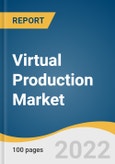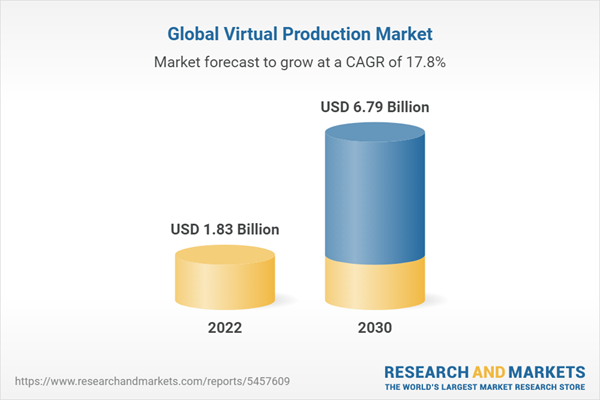The global virtual production market size is expected to reach USD 6.79 billion by 2030. The market is expected to expand at a CAGR of 17.8% from 2022 to 2030. The rising popularity of virtual production in the media and entertainment industry, combined with its capabilities to create high definition visuals and real-time virtual environments, is the key factor propelling the growth of the market.
The technology enables filmmakers to reduce the demand for on-set production teams and crew members by integrating virtual background environments into live-action footage. This allows for a significant reduction in video production costs. For instance, in 2020, after the Covid-19 pandemic, filmmakers in the Hollywood industry found the hi-tech solution of shooting without gathering 100s of people on set. The use of techniques such as cloudbusting, stagecraft LED setup, and robotic camera to shoot actors remotely, known as the Solo Cinebot has helped the filmmaker a lot.
Furthermore, technological advancement in virtual production helps broadcasters improve their operational efficiency with the least physical presence of technicians in the broadcasting room. For instance, in March 2020, Sky Sports implemented a virtual production suite, which has enabled its teams to create content and stream it remotely. The suite connected 48 virtual workstations and an equal number of direct-to-workstation connections for remote editing, simultaneous live programming, and the distribution of live clippings directly on social media platforms. Although virtual production can produce a film with better visuals and low production costs, it also poses some challenges, especially from the lack of training and experience among industry professionals.
With the advent of artificial intelligence, virtual production technology has witnessed significant improvements in the quality of its computer-generated graphics. Design and visualization of all complex scenes in a three-dimensional model have become convenient, further editing and reviewing in a real-time environment. The technology positively impacts the market by reducing the transportation and logistics costs of crew members and equipment. It enables filmmakers to capture on-set live-action scenes through simul-cams or virtual cameras and seamlessly merge computer-generated 3D graphic elements with the film's live shooting footage to conclude with the final visual effects.
Furthermore, artificial intelligence facilitates pre-production support that helps to accelerate video production work. In the previous decade, pre-production works heavily relied on unstructured box office data and limited demographic information related to viewers, leading to less engaging video content development. However, now artificial intelligence can generate insights from large data sets collected from various platforms to understand the proposed content's acceptance and interest.
For example, Netflix creates video content based on accurate, personalized recommendations and observations of its users' behavior, such as surfing history, claim, and data action like pausing or rewinding videos. In addition, in April 2021, the company decided to invest USD 17 billion to create a dedicated database to develop original content based on its platform's collected data. Artificial intelligence technology can also help understand scripts and screenplays to recognize the locations described and suggest real-world locations where directors can imagine and create realistic computer graphic imagery locations.
The growing implementation of virtual production in the gaming industry also works well for the market. Factors such as leveraging a three-dimensional environment, increased focus of companies on developing compact and comfortable virtual gaming devices, and constant technological innovation on virtual production platforms, such as 3D audio, untethered virtual reality headsets, and cloud scalability, are expected to fuel the market growth across gaming applications. Furthermore, introducing an immersive experience allows for 360° views of graphic content and a new level of gaming interaction, thus enabling players to control and modify the gaming environment through their senses. This made the interaction with the video games smoother for the player. Hence, the increased application of virtual production technology in games is expected to propel the growth of the market.
This product will be delivered within 1-3 business days.
The technology enables filmmakers to reduce the demand for on-set production teams and crew members by integrating virtual background environments into live-action footage. This allows for a significant reduction in video production costs. For instance, in 2020, after the Covid-19 pandemic, filmmakers in the Hollywood industry found the hi-tech solution of shooting without gathering 100s of people on set. The use of techniques such as cloudbusting, stagecraft LED setup, and robotic camera to shoot actors remotely, known as the Solo Cinebot has helped the filmmaker a lot.
Furthermore, technological advancement in virtual production helps broadcasters improve their operational efficiency with the least physical presence of technicians in the broadcasting room. For instance, in March 2020, Sky Sports implemented a virtual production suite, which has enabled its teams to create content and stream it remotely. The suite connected 48 virtual workstations and an equal number of direct-to-workstation connections for remote editing, simultaneous live programming, and the distribution of live clippings directly on social media platforms. Although virtual production can produce a film with better visuals and low production costs, it also poses some challenges, especially from the lack of training and experience among industry professionals.
With the advent of artificial intelligence, virtual production technology has witnessed significant improvements in the quality of its computer-generated graphics. Design and visualization of all complex scenes in a three-dimensional model have become convenient, further editing and reviewing in a real-time environment. The technology positively impacts the market by reducing the transportation and logistics costs of crew members and equipment. It enables filmmakers to capture on-set live-action scenes through simul-cams or virtual cameras and seamlessly merge computer-generated 3D graphic elements with the film's live shooting footage to conclude with the final visual effects.
Furthermore, artificial intelligence facilitates pre-production support that helps to accelerate video production work. In the previous decade, pre-production works heavily relied on unstructured box office data and limited demographic information related to viewers, leading to less engaging video content development. However, now artificial intelligence can generate insights from large data sets collected from various platforms to understand the proposed content's acceptance and interest.
For example, Netflix creates video content based on accurate, personalized recommendations and observations of its users' behavior, such as surfing history, claim, and data action like pausing or rewinding videos. In addition, in April 2021, the company decided to invest USD 17 billion to create a dedicated database to develop original content based on its platform's collected data. Artificial intelligence technology can also help understand scripts and screenplays to recognize the locations described and suggest real-world locations where directors can imagine and create realistic computer graphic imagery locations.
The growing implementation of virtual production in the gaming industry also works well for the market. Factors such as leveraging a three-dimensional environment, increased focus of companies on developing compact and comfortable virtual gaming devices, and constant technological innovation on virtual production platforms, such as 3D audio, untethered virtual reality headsets, and cloud scalability, are expected to fuel the market growth across gaming applications. Furthermore, introducing an immersive experience allows for 360° views of graphic content and a new level of gaming interaction, thus enabling players to control and modify the gaming environment through their senses. This made the interaction with the video games smoother for the player. Hence, the increased application of virtual production technology in games is expected to propel the growth of the market.
Virtual Production Market Report Highlights
- In terms of end-user, the movies segment held the largest revenue share in 2021. The growth can be attributed to the rising demand for visual effects and a three-dimensional model in movies.
- Based on component, the software segment is expected to grow at a significant rate over the forecast period owing to the inclusion of artificial intelligence. The inclusion is expected to improve the performance of animation and graphics quality.
- by type, the post-production segment held the largest revenue share of over 50.0% in 2021. This can be attributed to its crucial role in editing and collaborating post-shoot videos with graphics and visual effects (VFX).
This product will be delivered within 1-3 business days.
Table of Contents
Chapter 1 Methodology and Scope
Chapter 2 Executive Summary
Chapter 3 Virtual Production Market Variables, Trends & Scope
Chapter 4 Virtual Production: Component Outlook
Chapter 5 Virtual Production: Type Outlook
Chapter 6 Virtual Production: End-User Outlook
Chapter 7 Virtual Production: Regional Outlook
Chapter 8 Competitive Landscape
Companies Mentioned
- 360Rize
- Adobe
- Arashi Vision Inc. ( Insta 360)
- Autodesk Inc.
- Boris Fx, Inc.
- Epic Games, Inc.
- Htc Corporation (Viveport)
- Humaneyes Technologies
- Mo-Sys Engineering Ltd.
- Nvidia Corporation
- Panocam3D.Com
- Pixar (The Walt Disney Company)
- Side Effects Software Inc. (Sidefx)
- Technicolor
- Vicon Motion Systems Ltd.
Methodology

LOADING...
Table Information
| Report Attribute | Details |
|---|---|
| No. of Pages | 100 |
| Published | April 2022 |
| Forecast Period | 2022 - 2030 |
| Estimated Market Value ( USD | $ 1.83 Billion |
| Forecasted Market Value ( USD | $ 6.79 Billion |
| Compound Annual Growth Rate | 17.8% |
| Regions Covered | Global |
| No. of Companies Mentioned | 15 |









